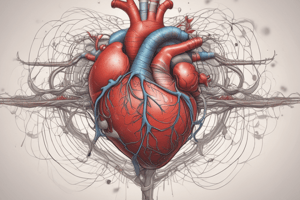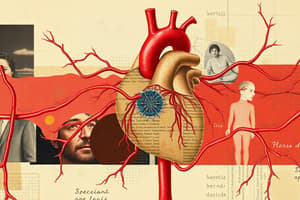Podcast
Questions and Answers
What does LVEDV stand for and why is it significant in understanding heart function?
What does LVEDV stand for and why is it significant in understanding heart function?
LVEDV stands for Left Ventricular End-Diastolic Volume, and it is significant because it represents the volume of blood in the left ventricle at the end of diastole, influencing ejection fraction and overall cardiac efficiency.
How does blood flow redistribution during exercise enhance skeletal muscle performance?
How does blood flow redistribution during exercise enhance skeletal muscle performance?
During exercise, blood flow is reduced to organs with lower activity, like the stomach and kidneys, allowing more blood to reach working muscles which have a higher demand for oxygen and nutrients.
What cardiovascular adaptations occur as a result of training that would lead to an increased stroke volume?
What cardiovascular adaptations occur as a result of training that would lead to an increased stroke volume?
Training leads to increased ventricular volume, thicker ventricular walls due to hypertrophy, and improved force of contraction, all contributing to a higher stroke volume.
What is the normal range for ejection fraction (EF) and why is it an important measure?
What is the normal range for ejection fraction (EF) and why is it an important measure?
How does regular cardiovascular training affect heart rate at rest and during exercise?
How does regular cardiovascular training affect heart rate at rest and during exercise?
What is the main role of the myocardium in the heart?
What is the main role of the myocardium in the heart?
How does a myocardial infarction occur?
How does a myocardial infarction occur?
What is the purpose of the heart valves?
What is the purpose of the heart valves?
What happens during systole in the cardiac cycle?
What happens during systole in the cardiac cycle?
Define blood pressure in terms of systolic and diastolic measurements.
Define blood pressure in terms of systolic and diastolic measurements.
What initiates the electrical activity of the heart?
What initiates the electrical activity of the heart?
What is the role of the P wave in an electrocardiogram?
What is the role of the P wave in an electrocardiogram?
What is the function of the intercalated discs in myocardium cells?
What is the function of the intercalated discs in myocardium cells?
Describe the function of red blood cells.
Describe the function of red blood cells.
Explain the role of the AV node during the cardiac cycle.
Explain the role of the AV node during the cardiac cycle.
What causes the QRS complex in an electrocardiogram?
What causes the QRS complex in an electrocardiogram?
Explain the skeletal muscle pump and its importance in venous return.
Explain the skeletal muscle pump and its importance in venous return.
How does preload affect stroke volume according to the Frank-Starling law?
How does preload affect stroke volume according to the Frank-Starling law?
Define cardiac output and how it is calculated.
Define cardiac output and how it is calculated.
What is the role of epinephrine in regulating heart function during exercise?
What is the role of epinephrine in regulating heart function during exercise?
What impact does venoconstriction have during exercise?
What impact does venoconstriction have during exercise?
What is the primary function of systemic circulation?
What is the primary function of systemic circulation?
Describe the pathway of deoxygenated blood during pulmonary circulation.
Describe the pathway of deoxygenated blood during pulmonary circulation.
What is coronary circulation and why is it important?
What is coronary circulation and why is it important?
How does the body respond to increased oxygen demands during exercise?
How does the body respond to increased oxygen demands during exercise?
Explain what cardiovascular drift is during prolonged exercise.
Explain what cardiovascular drift is during prolonged exercise.
During exercise, how is blood flow redistributed in the body?
During exercise, how is blood flow redistributed in the body?
What happens to stroke volume and heart rate as a person reaches their VO2 max during exercise?
What happens to stroke volume and heart rate as a person reaches their VO2 max during exercise?
Why do we call the heart a double pump?
Why do we call the heart a double pump?
Flashcards
Systemic Circulation
Systemic Circulation
The circulation that delivers oxygenated blood from the heart to the body and returns deoxygenated blood back to the heart.
Pulmonary Circulation
Pulmonary Circulation
The circulation that carries deoxygenated blood from the heart to the lungs for oxygenation and returns oxygenated blood back to the heart.
Coronary Circulation
Coronary Circulation
The system of blood vessels that supplies blood to the heart muscle itself.
Cardiac Output (Q)
Cardiac Output (Q)
Signup and view all the flashcards
How body responds to ↑ oxygen demands in muscle during exercise.
How body responds to ↑ oxygen demands in muscle during exercise.
Signup and view all the flashcards
Cardiovascular Drift
Cardiovascular Drift
Signup and view all the flashcards
Redistribution of Blood Flow
Redistribution of Blood Flow
Signup and view all the flashcards
Why do we call the heart a double pump?
Why do we call the heart a double pump?
Signup and view all the flashcards
What does the P wave on an ECG represent?
What does the P wave on an ECG represent?
Signup and view all the flashcards
What does the QRS complex on an ECG represent?
What does the QRS complex on an ECG represent?
Signup and view all the flashcards
What does the T wave on an ECG represent?
What does the T wave on an ECG represent?
Signup and view all the flashcards
What is the primary function of red blood cells (RBCs)?
What is the primary function of red blood cells (RBCs)?
Signup and view all the flashcards
How does the skeletal muscle pump contribute to venous return?
How does the skeletal muscle pump contribute to venous return?
Signup and view all the flashcards
How does the thoracic pump assist venous return?
How does the thoracic pump assist venous return?
Signup and view all the flashcards
How does venoconstriction help with venous return?
How does venoconstriction help with venous return?
Signup and view all the flashcards
Explain the Frank-Starling Law in terms of stroke volume.
Explain the Frank-Starling Law in terms of stroke volume.
Signup and view all the flashcards
What is Myocardium?
What is Myocardium?
Signup and view all the flashcards
What is a Myocardial Infarction?
What is a Myocardial Infarction?
Signup and view all the flashcards
What is the Path of Blood Flow in the Heart?
What is the Path of Blood Flow in the Heart?
Signup and view all the flashcards
What is the function of valves in the heart?
What is the function of valves in the heart?
Signup and view all the flashcards
What is Ventricular Systole?
What is Ventricular Systole?
Signup and view all the flashcards
What is Ventricular Diastole?
What is Ventricular Diastole?
Signup and view all the flashcards
How does the heart's electrical activity initiate contraction?
How does the heart's electrical activity initiate contraction?
Signup and view all the flashcards
What is the difference between Systolic and Diastolic blood pressure?
What is the difference between Systolic and Diastolic blood pressure?
Signup and view all the flashcards
What is LVEDV?
What is LVEDV?
Signup and view all the flashcards
What is Ejection Fraction (EF)?
What is Ejection Fraction (EF)?
Signup and view all the flashcards
How does blood flow change during exercise?
How does blood flow change during exercise?
Signup and view all the flashcards
What are the cardiovascular effects of training?
What are the cardiovascular effects of training?
Signup and view all the flashcards
How does training affect blood volume?
How does training affect blood volume?
Signup and view all the flashcards
Study Notes
Cardiovascular System
-
Systemic Circulation: Delivers oxygenated blood from the heart to the body and returns deoxygenated blood to the heart.
- Oxygenated blood enters the left atrium through pulmonary veins.
- The blood then passes through the bicuspid valve and is pumped from the left ventricle to the aorta and then to the arteries to the body.
-
Pulmonary Circulation: Carries deoxygenated blood from the body to the heart to the lungs for oxygenation, and returns oxygen-rich blood to the heart.
- Deoxygenated blood enters the heart through the superior and inferior vena cava into the right atrium.
- It then moves into the right ventricle through the tricuspid valve, and is pumped into the pulmonary artery.
- The blood travels to the lungs, goes through gas exchange (Co2 for O2 in alveoli) and returns to the heart.
-
Coronary Circulation: The system of blood vessels that supplies blood to the heart muscle (myocardium).
- Oxygenated blood flows to the heart through coronary arteries which branch off the aorta.
- The blood delivers O2 through capillary beds.
- Deoxygenated blood returns via cardiac veins to the right atrium.
Changes in Cardiac Output During Exercise
- Heart rate (HR) and stroke volume (SV) increase with the intensity of exercise. This leads to an increased cardiac output (Q).
- In untrained individuals, HR and Q plateau at the maximal oxygen uptake (VO2 max).
- With higher intensity exercise, SV increases because of higher systolic pressure and lower peripheral resistance.
- Prolonged exercise can lead to cardiovascular drift, where SV decreases slightly as heart rate increases.
- Increased body temperature leads to dehydration and lower plasma volume.
- This leads to reduced venous return to the heart.
- If below lactate threshold, a steady state level should be reached within 1-4 minutes.
Redistribution of Blood Flow
- Blood flow to muscles increases from 15-20% at rest to 80–85% during maximal exercise.
- Blood flow to other organs like the liver, kidneys, and skin is reduced.
Myocardium
- The heart muscle tissue is involuntary and striated.
- Cells are connected by intercalated discs, allowing for coordinated contractions.
- Calcium ions and sliding filament theory activate the muscle contractions.
Myocardial Infarction (Heart Attack)
- When blood flow to the heart muscle cannot reach the demand, the tissues begin to damage and die from lack of oxygen.
- Fatty plaque buildup in coronary arteries causes blockages and blood flow interruption.
Path of Blood Flow Through the Heart
The blood circulates through the heart using specific valves and chambers to ensure one-way flow. This process is regulated by the conductive system of the heart.
Cardiac Cycle
- Systole: Atrial and ventricular contractions that pump blood. It takes approximately 0.5 seconds. Atria contract first, followed by ventricles, pumping blood forward.
- Diastole: Relaxation phase between contractions, lasting about 0.3 seconds. The heart fills with blood.
Electrical Activity in the Heart
- The sinoatrial (SA) node initiates the heartbeat.
- The signal travels through the atria, causing them to contract.
- The atrioventricular (AV) node then transmits the signal to the ventricles.
- The signal travels through the bundle of His and Purkinje fibers, causing the ventricles to contract .
Conductive Pathway and Electrocardiogram (ECG)
- P wave: SA node signal spreads through the atria
- QRS complex: Ventricular contraction
- T wave: Ventricles relax
Blood Functions
- Transport oxygen and nutrients
- Regulate temperature and pH
- Distribute heat throughout the body.
Blood Components
- Plasma
- Red blood cells (RBCs)
- White blood cells (WBCs)
Studying That Suits You
Use AI to generate personalized quizzes and flashcards to suit your learning preferences.




